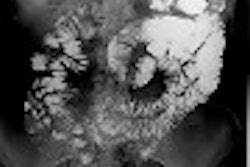CT can accurately depict gastrointestinal tract involvement in peripheral T-cell lymphoma (PTCL) if it is not confined to the mucosa, according to researchers from the University of Ulsan College of Medicine in Seoul, Korea. However, the modality may not play a critical role in detecting primary lesions when there is little or no mural involvement, they concluded.
Dr. Jae Ho Byun, Dr. Hyun Kwon, Dr. Ah Young Kim and colleagues from the departments of radiology, pathology, and internal medicine described PTCL as a rare disease that typically affects middle-aged and elderly patients.
"At immunohistochemical staining, lymphomas bearing a mature T9-cell phenotype or natural killer cells (i.e., excluding mycosis fungoides or cutaneous T-cell lymphoma) have been grouped together as PTCL," they wrote.
Amid much controversy regarding classification, PTCLs comprise several clinicopathologic entities, including unspecified, angioimmunoblastic T-cell lymphoma, angiocentric lymphoma, intestinal T-cell lymphoma, and adult T-cell lymphoma or leukemia. Most gastrointestinal-tract lymphomas are non-Hodgkins lymphomas of B-cell origin, the authors wrote in Radiology (April 2003, Vol. 227:4, pp. 59-67).
PTCLs that develop primarily in the gastrointestinal tract are commonly associated with malabsorption, but many PTCL patients have no history of celiac disease or gluten sensitivity, with normal-appearing jejunal mucosa. Some studies suggest poor prognosis for PTCL, while others conclude that outcomes are no worse than for B-cell lymphoma patients.
CT is increasingly being used for evaluation of suspected gastrointestinal lymphoma because it can assess both mural and extramural components of disease, and allows accurate staging and follow-up of treatment response, Byun and colleagues wrote.
Of 262 patients diagnosed with gastrointestinal lymphoma at the authors' institution, 94% had B-cell lymphoma, and 6% (16) had a diagnosis of PTCL. Following exclusion of two patients whose CT scans were not available, CT scans were retrospectively reviewed in 14 patients with pathologically proven PTCL of the gastrointestinal tract.
The aim of the study was to evaluate CT's accuracy in depicting gastrointestinal tract involvement on PTCL.
Contrast-enhanced CT had been performed in all patients following the administration of oral contrast in 8 patients (900 mL of a 2% barium suspension an hour before the scan) and 120 mL of iopamidol (Bracco, Milan, Italy) administered at 3 mL/sec using a digital injection system approximately 72 seconds before scanning.
Three CT scanners were used to acquire images with 7- or 10-mm collimation and a pitch of 1 to 1.5 from the dome of the diaphragm to the synthesis pubis. The images were reviewed by two radiologists who were aware of the PTCL diagnosis, but blinded to the location of the involvement and to endoscopic, surgical, and biopsy findings. The group also evaluated the presence or absence of lymphadenopathy, bowel obstruction, bowel perforation, intussiception, ascites, and other abdominal organ involvement.
Gastric lymphoma patterns were classified as diffuse infiltration of more than 50% of the length of the stomach, segmental infiltration, and polypoid form, and further labeled as circumferential, cavitary, localized polypoid, or mesenteric nodal form. Bowel was deemed thickened at 5-mm thickness in the stomach and 3-mm thickness in the small intestine and colon. PTCL was classified using a system delineated by the International Lymphoma Study Group.
According to the results, 3/14 patients had disease confined to the gastrointestinal tract without demonstrated lymph node or other abdominal organ involvement, the authors wrote.
Three patients had localized (n=2) or diffuse (n=1) abdominal lymphadenopathy, and the remaining eight patients had generalized disease involving the gastrointestinal tract, as well as other organs or anatomic structures, including in the liver (n=5), spleen (n=4), bone marrow (n=2), cervical lymph node (n=2), bone (n=1), hypopharynx (n=1), lung (n=1), and/or the skin (n=1).
Five patients had hepatomegaly, 4 had splenomegaly, 1 had hypoattenuating masses of the liver, and 1 had multiple osteolytic lesions in the spine and pelvic bone. There was bowel perforation in three patients with CT evidence of pneumoperitoneum, extensive ascites, and diffuse omental and mesenteric infiltration combined with peritoneal thickening.
CT correctly diagnosed 11/14 patients. Of those, CT clearly demonstrated PTCL as bowel or gastric wall thickening in 10 patients and as a polypoid mass in 1. Bowel thickening was mild in 10 patients, moderate in three, and severe (> 2 cm) in one. However, CT failed to depict gastrointestinal involvement in the remaining three patients, the authors wrote.
"CT failed to depict gastrointestinal involvement in one patient who had only diffuse bowel dilatation, with excess fluid in the entire small intestine," they wrote, even though use of oral and intravenous contrast was optimal in all patients. "Seven of the remaining eight patients in whom CT was successful in depicting the gastrointestinal lesions had circumferential bowel wall thickening."
The bulky or diffuse regional or mesenteric lymphadenopathy in gastrointestinal lymphoma is a reliable CT feature that helps distinguish PTCL from other gastrointestinal lesions, Byun and colleagues wrote. "However, our study findings showed that lymphadenopathy seen in eight (57%) of our 14 patients was nonbulky. Thus, nonbulky lymphadenopathy is also considered strikingly different from B-cell lymphomas. When abdominal solid organs were involved, the main CT finding included hepatosplenomegaly or multiple hypoattenuating masses; this did not differ from those characteristics in B-cell lymphoma."
Thus, when minor bowel wall thickening is combined with nonbulky lymphadenopathy or pneumoperitoneum, the diagnosis may be confused with other gastrointestinal diseases such as inflammatory bowel disease or vascular disorders, the group wrote.
"However, PTCL should be included in the list of differential diagnoses at CT when the duodenum or the jejunum is a preferential site of intestinal involvement, when multifocal bowel involvement is seen, and when there is evidence of bowel perforation or diffuse peritonitis," they wrote. Observation of the other organs is also very helpful in establishing the diagnosis, as is a clinical history of malabsorption.
CT can depict gastrointestinal PTCL if it is not confined to the mucosa, they concluded. "In PTCL involving the gastrointestinal tract, there is a tendency toward preferential jejunal or duodenal involvement, as well as bowel perforation with both minimal bowel wall thickening and lymphadenopathy, and thus the condition mimics inflammatory or vascular gastrointestinal disorders."
By Eric BarnesAuntMinnie.com staff writer
April 22, 2003
Related Reading
FDG-PET signals early response of malignant GI tumors to Gleevec, July 1, 2002
Copyright © 2003 AuntMinnie.com



















